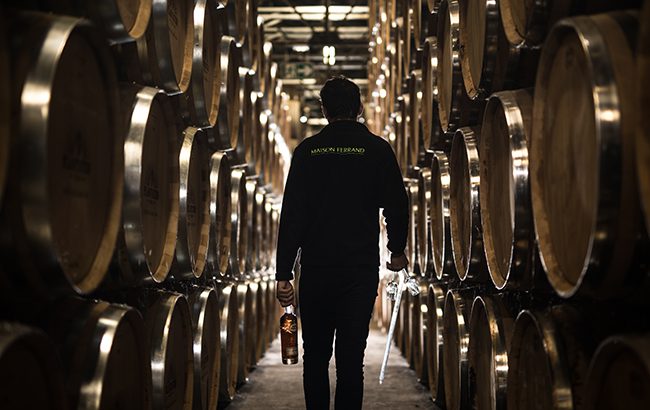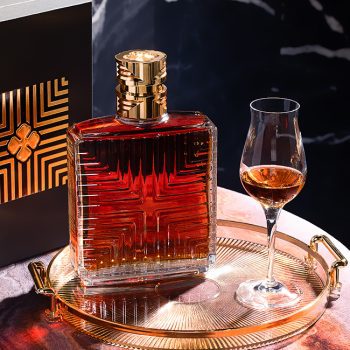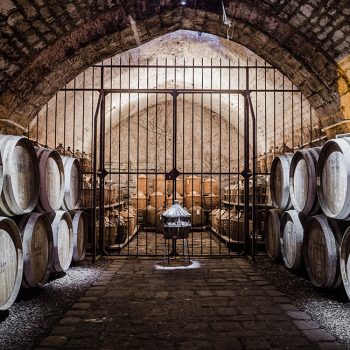Why Cognac is stuck in limbo land
By Rupert HohwielerCognac producers are feeling the crunch, thanks to their biggest markets being in a state of uncertainty.

*This feature was first published in the May 2025 issue of The Spirits Business magazine.
It’s no secret Cognac is in a difficult predicament. Trade body the Bureau National Interprofessionnel du Cognac (BNIC) says in 2024, the value of Cognac shipments fell to €3 billion (US$3.1bn), which represents a double-digit drop on the previous year of 10.6%. The volume of Cognac exports may have risen slightly – by 0.4% in 2024 – but the decline in value is a concern for producers.
The category’s biggest-selling brands have all posted major declines in the past 12 months. Hennessy owner LVMH saw spirits sales fall by 14% in 2024; Martell plunged by 25% during the first half of Pernod Ricard’s financial year; and Rémy Cointreau (owner of Rémy Martin) reported a 19% sales drop for Cognac in the first nine months of its 2024-25 financial year. Tricky trading conditions in the category’s two biggest markets, the US and China, are largely identified as the root cause.

Value vs volume
China’s anti-dumping investigation into EU brandy (of which Alexandre Gabriel, master blender and owner of Maison Ferrand, says more than 90% is Cognac) has seen fewer older Cognacs exported to China, while younger ones, less expensive than XO, are still being exported to North America, creating the discrepancy between value and volume. Raphaël Delpech, general manager of the BNIC, says the effects of the anti-dumping probe (which began at the start of 2024 and is due to wrap up on 5 July) are now “clearly noticeable” – and the “impact is a huge negative”.
He adds: “Since the taxes were imposed, we’ve been losing €60 million each month in China. If the dynamic continues after the decision in a few months, we can imagine that there will no longer be Cognac in China.”
Delpech stresses the region is hoping for movement from the negotiations, but admits “we are lacking time now. If they apply, it’s for five years, which is an eternity.”
Meanwhile, in the US, there is also uncertainty but separate to what’s going on in China. At the time of writing, the tariff threat back and forth between president Donald Trump and the European Union (EU) saw the EU facing a 10% duty on exports to the US instead of 20%, at least until July.
With this being around the same time the investigation with China is set to end, the month feels make or break for the category.
Delpech calls the US situation “opaque”, explaining that it’s “difficult to make provisions on what will be happening. We know that the US is our critical market and we believed a few months ago that after its elections, the economy would increase and that all this would be good, supposedly, for our business, but that is not what we are witnessing today.”
Maison Ferrand’s Gabriel says the region is hurting, especially with its historically close connections with China and the US under fire. He hopes governments can come to good senses in terms of trade. “This is part of our heritage as a region – trading with one another, it’s an act of love, it’s an act of knowing somebody else, especially if it’s delicious products such as spirits,” he says. “People are extremely worried because China and the US are the first- and second-largest economies in the world, and also the two main markets for Cognac. For some, it’s more than 70% of their sales.”

Cognac is sold in 140 countries, and Gabriel cites South Africa, the Caribbean, Eastern and Northern Europe, and South Asia as alternative markets that can be worked on. Sometimes France is forgotten as a market where there is new demand from consumers. On Cognac’s home base rediscovering its national spirit, he says: “There’s a patriotic movement from this global ‘harshness’, where people are falling back on their local spirits, and French people love fine spirits. We’re lucky, in fact, that in Europe people are now going for high-grade spirits. You know, drinking less, drinking better. This is benefitting Cognac.” He stresses, though, that while the pendulum is swinging in these directions, it can take 10-15 years for it to swing at full strength. “The problem is urgent. Yes, this is part of the solution, but we have to make sure everybody is still there, so the government realises that trade and trading with one another is paramount to countries working well together. History has proven us right on this.”
Per Even Allaire, sales director at Hine, doesn’t mince his words when he says that in the short term, the situation for Cognac is a “proper catastrophe. We haven’t seen a crisis to this extent for almost 40 years.”
Expanding on alternative market strategies, he feels Cognac getting out of its “dusty atmosphere” that it had for past decades has helped in emerging regions.
“I see a lot of opportunities in the medium to long term,” he continues. “I see some opportunities here in France. Generally speaking, it’s important for the category.”
Hine is well-spread for export destinations, as Allaire says: “As far as we’re concerned, I would say the proportions of exports to various regions in the world is pretty well-balanced, luckily for us.” Despite this, he calls South Africa (the third biggest export market for Cognac) a “red ocean – fierce competition, low prices, and heavy investments. If you’re not a big player, it’s kind of difficult to wait through this. There are smaller markets with small opportunities, and that’s where we try to look.”
Allaire also points to travel retail and the UK, where Hine has “big expectations” and has reinvested. “We have some activations in London, at Heathrow in May. We are re-engaging in the UK. In the medium to long term, I can’t see Cognac disappearing from the map, despite what happens with China,” he says of the potential of losing such a major market. “We need to bite the bullet and try to continue rejuvenating the category.”

Another part of the discrepancy between volume and value was the rise in shipments of younger Cognacs, which were up by 13.7% in 2024. In China, Cognac is still consumed as a mark of status, and older products are more favoured than their younger counterparts. But with the anti-dumping investigation, these products (namely XO and above) have stalled. Discussing China, Anna Kim, chief marketing officer at Camus, thinks the demand is there, and the category is still “very solid, especially in the south, where they love Cognac”.
However, given the trade tension, she says “purchase power is limited, so that’s why you see that it is shrinking slightly”. In more lifestyle-led markets such as sub-Saharan Africa and Southeast Asia, a different dynamic has emerged. Kim explains that “over the past 18 months, we’ve seen renewed dynamism in the VS and VSOP segments. This is driven by shifts from mature markets to urban centres like Dubai, London, Bangkok, and Ho Chi Minh City.
She mentions Gen Z and Millennials, who drink these types of Cognac, and the way they consume them: “These consumers are curious, globally connected, and value craft and innovation over classic prestige cues. Female consumers are also driving growth, especially through cocktail culture and experiential tastings.”
Kim adds that Camus has “specifically seen strong traction with our VSOP Intensely Aromatic, which stands out for its floral and fruity profile crafted through our patented intensity-distillation method – younger drinkers and mixologists appreciate its expressiveness and versatility”.
Strong traction
Furthermore, with price inflation and luxury price fatigue, younger Cognacs have also become attractive entry points in the category, combining mixability and affordability, Kim says. XO Cognacs, on the other hand, have seen shipments plummet by 26.4% overall.
Of XO’s steep drop in shipments, Gabriel points to inflation alongside the “geopolitical mess. You see that in every category of spirits. It’s the same with single malts and with high-end rums, where people are being a little more careful. That has an effect on what people buy.” He says consumers might trade down from a bottle of XO to VSOP, in the way whisky buyers might purchase a cheaper bottle with a lower age statement. “Because the production of Cognac is so complicated and so resource-needy, it is a luxury category, and for many people, it is a gift for themselves, as an act of indulgence, or a gift to someone they care about.”
Camus’s bottle for its flagship XO – without any labelling, marked by geometric lines and sealed with a gold stopper – plays into gifting. “The idea was that Cyril Camus, the fifth-generation brand owner of Camus, wanted to make Cognac a central piece of the dinner table. It should be something beautiful. It should be something that you would keep in your home, that you can always refill,” Kim notes.
Better purchases
Allaire says the pricing challenges around XO and above are a “double effect” because “there is less buying power in most markets, so everyone is looking at perhaps making better purchases”. On top of that, tariffs make it even more necessary to be competitive on pricing.
He says: “That’s a double concern for most brands, and what we see, surprisingly or not, is that products that operate in the middle of the segment are suffering quite a lot. Entry level is probably doing a bit better, then at the very high end – well, people with money still have money. I see some opportunities also for the very high end of the pyramid in terms of price-positioning.”
Gabriel also sees opportunities in attracting visitors to the Cognac region, in the same vein as Scotch producers with their distilleries and landscapes. “Cognac is very vibrant and modern, and you have a whole fabric of 4,000 vine growers that can be visited.”

He says Cognac houses need to open up more – noting his own house and Rémy Martin are upgrading their visitor centres, as well as the work Martell is doing with luxury experiencess, such as inviting guests to stay at its historic Château de Chanteloup.
“Cognac was always very popular worldwide, but the houses were very secretive,” he says. “There’s an opportunity to say ‘come and check us out’. The southwest of France is beautiful. There’s a vision now to say ‘look, Scotland is getting two million people visiting’. That’s wonderful, and we look up to this – even the whiskey trail in America.
In 2024, it celebrated the 2.7-million-visitor landmark. Cognac [attracts] just below 300,000 people. There’s an opportunity to have people discover our region and spirit. It’s a way to show the authenticity of the spirit itself.”
Delpech also notes how maisons are working to improve their offerings to tourists, but the number one priority is diplomacy. “We are a symbol of France. We are seen as a part of French culture. It’s a blessing for us, but also sometimes a difficulty. Each time a country wants to send a message to France, it might do it through Cognac. So diplomacy, in this context, is something that is critical, and we are trying to get it understood at the highest level in France, in Europe, China and maybe the US as well,” he says.
Hine’s Allaire remains optimistic: “As far as we’re concerned, we are 261 years young. We’ve faced challenges before, and it’s part of the circle of life and business.”
Gabriel is on the same wavelength: “Cognac has always had ups and downs, but we believe it is eternal. We hope all these different governments in their wisdom will come to their senses. That, to us, is extremely important.”
What strategies do you have in place to navigate the current trade and tariff challenges?
Olivier Charriaud – CEO, Maison Boinaud
“These are undeniably complex times for the spirits industry, as has been the case repeatedly in the past, but we believe that challenges can also open the door to new ideas. We’re staying agile – closely connected with our partners and constantly listening to what the markets are telling us. We stay focused on innovation, while staying true to ourselves, creating products that reflect genuine French savoir-faire and a commitment to quality. It’s a balance between moving forward and staying grounded in what we do best. There’s no standing still. Sometimes, success simply means having the courage to keep going – even when the road ahead isn’t easy. We’re doing our best to adapt, to stay relevant, and to continue building meaningful, lasting brands.”
Alexis Cabanne – CEO, Famille Cabane
“In light of increasing trade tensions, we’re adjusting our strategy by diversifying our markets and reinforcing our international presence, particularly in emerging Southeast Asian countries. We’re staying alert to regulatory, tariff and customs changes in the US and China.”
Eric Le Bouar – managing director, Delamain
“At Delamain, we occupy a different space to the bigger Cognac houses as we are much less exposed to just one or two markets. In fact, for us, no one market makes up more than 15% of our business so we are slightly more protected from trade and tariff challenges. As a house, our focus is on producing small quantities of the very best Cognacs, and our aim is for these to be sold in the very best places across the globe (such as Michelin-starred restaurants, and five-star hotels) so this, again, naturally spreads out the volume of what we sell, protecting us slightly from the current pressures.”
Related news
Is the French market key to Cognac’s revival?
